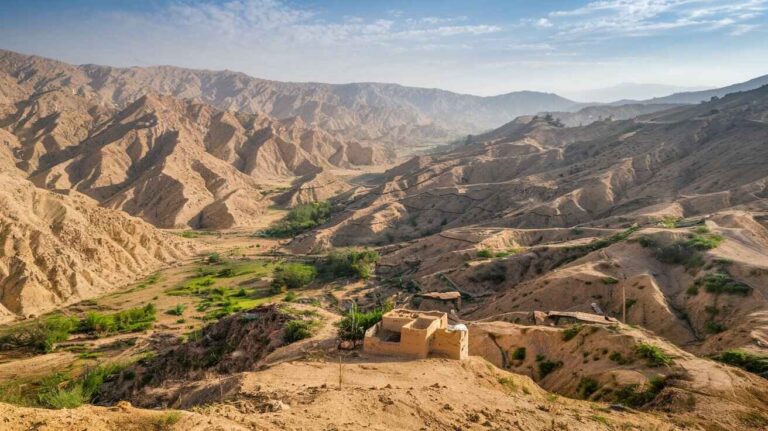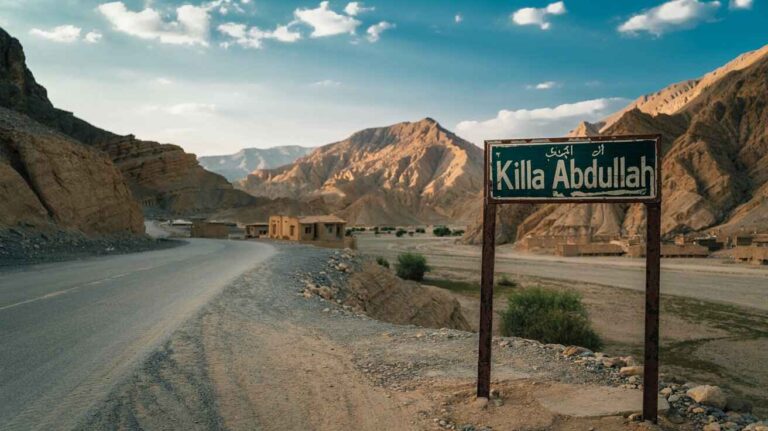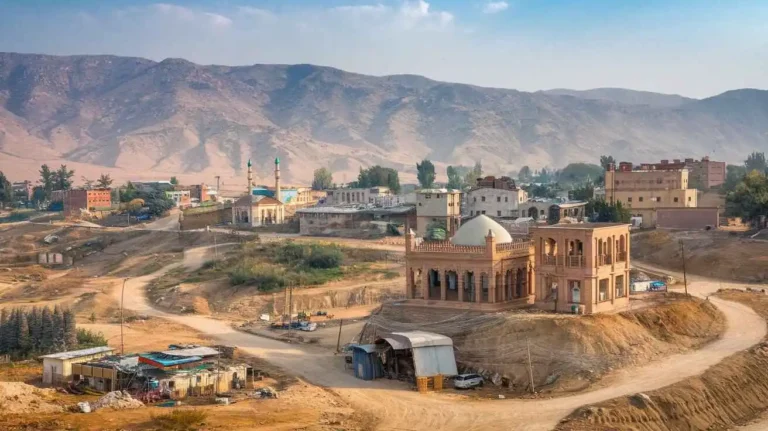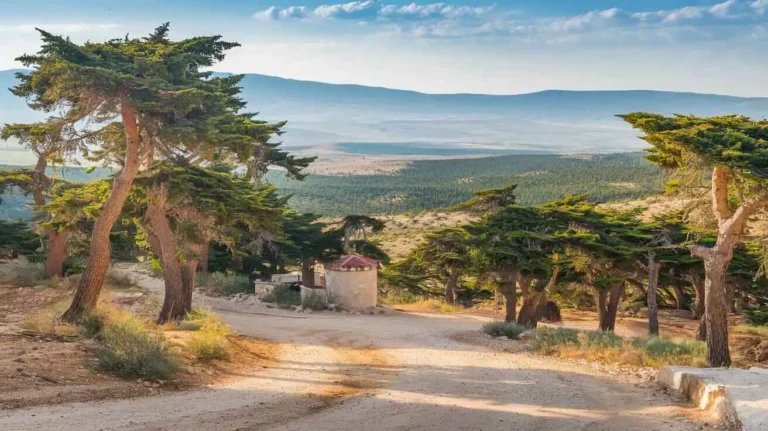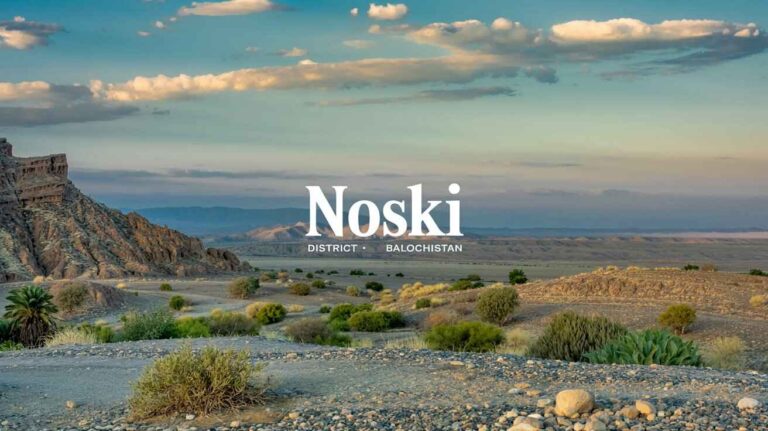Heart of Balochistan: Journey of Chagai District
Chagai District
Chagai District, located in the westernmost part of Balochistan, is an area rich in geological history and physiography, with fascinating igneous rock formations and a unique topography that shapes its landscape. This region, bounded by Pakistan’s border with Iran, holds numerous geological secrets and serves as an important resource hub for mineral exploration. Spanning a large area of sandy, stony deserts and mountains, Chagai is a perfect blend of natural resources, strategic location, and rich cultural heritage.
Geology and Geological Evolution of Chagai
Chagai is home to a variety of geological formations that tell the story of millions of years of tectonic activity and volcanic events. The region is dominated by the Sinjrani Volcanic Group, which comprises andesite and quartz monzonite, and covers over 60% of the mapped area. The Cretaceous to Pleistocene volcanic rocks in the area are some of the oldest exposed in Pakistan, with Sinjrani Volcanic Group being one of the most significant formations.
The Chagai intrusions, which include granite, gabbro, and quartz diorite, are also a key feature of the area’s lithology. These igneous rocks, along with the volcanic remnants of the Koh-i-Sultan Volcanic Group, provide an essential record of magmatic processes over millions of years.
In terms of tectonics, the region’s structural evolution has been shaped by the Himalayan orogeny, which culminated in the folding and faulting seen today. The area remains seismically active, with destructive earthquakes continuing to release stress along major faults. The Chagai region has thus witnessed significant deformation, with volcanic intrusions that have significantly impacted the sedimentary formations in the region.
Physiography and Topographical Features
Chagai’s physiography is characterized by mountains, sandy deserts, and stony landscapes. The region is primarily bounded by the western Chagai Hills, with elevations ranging from 2,900 feet to 5,200 feet above base level. The district is dissected by several streams and nalas, such as Malik Naro and Malik Teznan, that drain water to the north, west, and south.
The district’s mountain peaks, such as the highest point at 8,061 feet (Malik Teznan), are surrounded by alluvium-covered plains and valleys, forming a diverse landscape. The stream patterns in Chagai vary depending on the underlying rock structures, with some areas showcasing well-developed drainage patterns due to the resistant Sinjrani Volcanic Group, while other regions, such as Nok Kundi, have less developed patterns.
Igneous Rocks and Volcanic Influence
A significant portion of Chagai’s geology is dominated by igneous rocks, especially those belonging to the Sinjrani Volcanic Group. These volcanic rocks, mainly of andesite, dolerite, and basalt composition, cover a large portion of the region and have had a profound influence on the lithological and metallogenic potential of the area.
The volcanic activity that shaped these rocks spans from Cretaceous to Pleistocene periods. The Sinjrani Volcanic Group consists of massive, dark-green to black, fine-grained rocks that show clear horizontal layering, which is an indication of their volcanic origin. This group of igneous rocks is a crucial part of the geological history of the Chagai Hills, which has further contributed to its mineral wealth, including deposits of copper, gold, and other minerals.
Metallogenic and Economic Potential
Chagai is known for its metallogenic potential, particularly in terms of mineral deposits. The region is home to significant mining projects like Saindak, which is a well-known copper-gold mine. These resources are primarily associated with the porphyry copper and volcanogenic massive sulphide deposits in the area. The geological settings, such as the Chagai intrusions and the Tethyan belt, make this district one of the most mineral-rich regions in Balochistan.
In addition to the copper and gold resources, the area also contains deposits of iron, marble, and granite, contributing to its economic potential. Saindak and Reko Diq are two major mining sites that have attracted international attention, with companies from China and Canada investing heavily in these projects. Reko Diq, in particular, is estimated to have significant copper-gold reserves, which makes it one of the largest mining projects in the region.
Cultural and Demographic Insights
The demographics of Chagai are equally diverse, with a population that has grown from 104,534 in 1951 to over 269,000 in 2023. The district’s population is predominantly Baloch, and the majority follows Islam, with some minorities practicing Christianity and Hinduism. Balochi is the most widely spoken language, followed by Brahui and Pashto.
The cultural landscape of Chagai is shaped by its unique geography, with various tribes and communities living in the region. The tribal system plays a significant role in the local governance, and the area has historically been part of the greater Balochistan cultural sphere. Chagai’s strategic location, at the crossroads of Pakistan and Iran, has made it a culturally and historically important area throughout the centuries.
Administrative and Political Structure
Administratively, Chagai is divided into several tehsils and union councils, with the largest being Dalbandin Tehsil and Nok Kundi Tehsil. The political landscape is dominated by tribal leadership, with various political figures such as Sadiq Sanjrani and Mir Amanullah Notezai playing key roles in shaping the region’s development.
Despite its remote location, Chagai has seen considerable growth in terms of infrastructure and educational facilities. The district has made significant strides in improving literacy rates, though challenges such as lack of infrastructure, particularly in rural areas, still persist.
Chagai District is an extraordinary region, blending geological wonders, rich mineral resources, and cultural diversity. Its strategic location and economic potential make it a key area in Balochistan. The district’s evolving physiography, igneous rock formations, and mineral wealth make it a region of both scientific and economic significance. As the region continues to develop, its role in the future of Pakistan and Balochistan will undoubtedly expand, making it an area to watch in the coming years.
Chagai District lies in the westernmost part of Balochistan, Pakistan, a region that is well known for its diverse geography, rich mineral resources, and unique climate. The district is often overshadowed by its larger counterparts but offers a wealth of historical and geographical significance. From its striking desert landscape to its thriving mining industry, Chagai’s identity is deeply rooted in its environment. This area is home to a mix of ethnic groups, primarily Baloch people, and has a population that is both diverse and spread across a vast, often isolated, region.
Climate and Geography of Chagai District
The climate of Chagai is extreme, with severe hot summers and cold winters that make the region a prime example of extreme climatic conditions. The hottest month is typically July, when the mean maximum temperature reaches an intense 43°C, and the minimum temperature doesn’t fall below 26°C. It is a district known for its sandstorms, particularly in the western part. The phenomenon, which can be associated with the bad-sad-o-bist roz, lasts for about 120 days, mainly occurring from mid-May to mid-September.
On the other hand, winter in Chagai can be severe, with frost appearing in January, the coldest month. During this period, the mean maximum temperature drops to about 17°C, and the mean minimum temperature can be as low as 1°C. The Monsoonal currents bring irregular and scanty rainfall, contributing to the mean annual rainfall of just 81 mm. During summer, the rainfall is almost negligible.
This combination of temperature extremes and low rainfall has shaped Chagai’s biodiversity, supporting a range of desert flora and fauna that are adapted to such conditions.
Seismic Activity in Chagai District
Chagai lies within Zone 2A on the Pakistan Seismic Zone Map, which indicates a moderate level of seismic activity. While the district is not subject to frequent, large-scale earthquakes, minor tremors occasionally affect the region. These earthquakes often cause minor damage but rarely result in significant destruction of property. The seismic activity in the region is a reminder of the natural forces at play beneath the surface of this historically rich landscape.
Population of Chagai District
The population of Chagai, as per the 2017 Census, stands at approximately 226,008 people. The district spans an area of 4,478 km², making it one of the larger districts in Balochistan. The population growth rate is recorded at 4.13%, reflecting the region’s dynamic yet slowly growing demographic. Among the population, 52.4% are male, and 47.6% are female. The district is predominantly rural, with only 7.2% of the population residing in urban areas.
The majority of Chagai’s population lives in two primary tehsils: Dalbandin Tehsil with a population of 185,205, and Nukundi Tehsil, which is home to 40,803 people.
Languages and Religions in Chagai District
The dominant language spoken in Chagai is Balochi, with 93.7% of the population using it as their first language. This is followed by smaller communities that speak Pushto (3.1%), Seraiki (0.5%), Urdu (0.3%), and Punjabi (0.8%).
When it comes to religion, 98.8% of the population in Chagai follows Islam, with the vast majority being Sunni Muslims. There are small communities of Hindus (0.7%) and Christians (0.2%), and the remaining population belongs to various smaller religious groups, such as Ahmadis and Schedule Castes.
Economic Activity in Chagai District
The economic activities in Chagai district are diverse, with a focus on agriculture, livestock breeding, and mining. About 25.5% of the population is involved in agriculture and livestock breeding, contributing significantly to the local economy. The livestock sector plays a crucial role, with goats, sheep, and cattle being the primary livestock species raised in the region. Fishing, though on a small scale, also provides a supplementary income to many families.
Additionally, Chagai is home to a thriving mining industry, with valuable minerals such as copper, gold, chromite, limestone, and onyx marble being extracted from the region. The presence of these minerals has not only attracted local entrepreneurs but also international mining companies, especially in areas like Saindak and Reko Diq. These mineral resources contribute greatly to the region’s economy and have positioned Chagai as an important player in Pakistan’s mining sector.
The district is also known for its handicrafts, particularly Balochi embroidery and traditional carpets, which are handmade by local women and sold in markets across the country. These products are an important source of income for many households in the region.
Agriculture and Land Use in Chagai District
Despite its arid environment, agriculture remains a vital part of Chagai’s economy, with 20.3% of the population engaged in farming activities. The district falls under the Tropical Agricultural Zone, which allows for the cultivation of various crops. Commonly grown crops include wheat, barley, maize, and cotton. Fruits such as apricots, peaches, and grapes are also grown, adding variety to the agricultural output. Vegetables like tomatoes, onions, and chilies are cultivated for local consumption and sale.
In terms of land use, the district has a total cultivated area of 142,773 hectares, with a large portion of the land being uncultivated due to the challenging climate. A significant portion of Chagai’s land is categorized as culturable waste, highlighting the untapped potential for agricultural expansion.
Livestock Breeding and Irrigation in Chagai District
Livestock breeding is an important activity for the rural population of Chagai, contributing to their livelihood and providing employment. As per Balochistan Development Statistics, goats, sheep, and camels are the most common livestock in the region, and they play a significant role in both the local economy and cultural practices. Chagai is known for its indigenous breeds of animals like the Kharani camel and the Morak goat.
Irrigation in Chagai is mainly reliant on springs, karezes, and wells. With only 9,657 hectares under irrigation, the region’s agricultural output is largely dependent on traditional methods, which are susceptible to fluctuations in water availability. There are several famous karezes in Chagai, such as the Muhammad Sharif Karez and the Dalbandin Karez, which have been in use for centuries to supply water to farms in this dry region.
Flora and Fauna of Chagai District
Chagai’s flora and fauna are uniquely adapted to the harsh desert environment. The region’s vegetation consists of xerophytic plants, which are well-suited to the dry conditions. Common plant species include wild pistachios, milk broom, and saltwort. The fauna of Chagai is similarly adapted to the desert, with species such as the desert fox, jackals, and desert deer roaming the landscape. Reptiles like the Indian desert monitor and the Caspian desert lacerta are also found in the area.
The Gut Forest Wildlife Sanctuary and Zawakhan Wildlife Sanctuary are among the notable protected areas in Chagai, offering refuge to various endangered species, including the markhor and ibex. These sanctuaries are essential in preserving the rich biodiversity of the region and protecting it from the growing threat of environmental pollution.
Chagai is a district located in Balochistan, Pakistan, near the Durand Line, which forms the Afghanistan–Pakistan border. The district is surrounded by significant geological features, including the Chagai Hills and Ras Koh Range. These hills, which are part of a larger mountain range, are primarily composed of granite and volcanic rock, making them a fascinating region for geological studies. The district’s topography consists of dry desert areas, with an extremely arid climate, adding to the harshness of this remote part of the country.
One of the most notable features in Chagai is Malik Naru, which stands as the highest peak in the region, towering at an impressive 7,915 feet (2,412 meters). This peak forms a central point in the Chagai Hills, which are a volcanic formation. The Koh-i-Sultan mountain, also within the Chagai Hills, is another prominent peak that adds to the rugged geography of the district. These geological formations make Chagai an area of interest not only for its scenic beauty but also for its rich natural resources and mineral deposits.
Chagai’s historical significance stretches far beyond its natural landscape. During the British colonial era, the British Geological Survey recognized the Chagai Hills for their rich mineral deposits, especially copper and gold. These resources have made the district an important area for mining in Pakistan. Saindak Copper Gold Project, established in the 1970s through a collaboration between Saindak Metals Ltd and the Government of Pakistan, remains a critical aspect of Chagai’s modern history. The project, which focuses on extracting valuable metals like gold, copper, and silver, has seen significant investments over the years, especially after 1995, when the Metallurgical Corporation of China (MCC) became involved. This collaboration continues to play a vital role in the economic development of the region.
The Saindak Copper-Gold Mine, located in Saindak town, processes ore at a capacity of approximately 7.25T per annum, contributing significantly to the national economy. The smelting process carried out at the mine has seen advances through the years, especially with the involvement of international companies like China Metallurgical Group Corporation. As of 2024, the mine is still operational and plays a critical role in the copper-gold industry, with ore processing capabilities set to be enhanced further.
Despite its resource-rich landscape, Chagai is not a region with abundant water resources. The dry desert conditions and the absence of water sources make it a challenging environment for agriculture and daily life. This has influenced both the development of the area and its population, who rely on limited water supplies for survival. Geological surveys conducted by the Geological Survey of Pakistan (GSP) in the 1980s highlighted the lack of significant water resources in the region. Yet, the people of Chagai have adapted to the harsh conditions, making use of ancient water management systems like karezes to ensure a steady supply of water.
Chagai’s strategic location near the Durand Line has made it a region of geopolitical importance. The Durand Line, which divides Afghanistan and Pakistan, is not just a political boundary but also a region of cultural and historical significance. The presence of military activity in this region, particularly during the Cold War era, added to its prominence. Furthermore, the district’s involvement in Pakistan’s nuclear tests in 1998, particularly in the Ras Koh Hills, has added a layer of mystique and international interest to Chagai’s history.
In terms of climate, Chagai is part of the arid zone of Balochistan. The district is outside the main monsoon belt, which results in extreme temperatures throughout the year. The summer months are particularly harsh, with average maximum temperatures often soaring to 45°C (113°F), while the winters can be bitterly cold, with average minimum temperatures dropping to as low as 2°C (36°F) in January. The climate of Chagai, combined with its dry desert topography, creates an environment that is as challenging as it is unique.
In addition to its geographical and historical significance, Chagai is a vital part of Pakistan’s mining industry. The Saindak Copper Gold Project is one of the major mining operations in the district, and its success is vital for the national economy. The project was initially launched in the 1970s and has undergone several phases of development and upgrades, with the involvement of global players such as China Metallurgical Group Corporation. The project’s processing capabilities have expanded over time, and it remains a cornerstone of Chagai’s modern economic structure. With future plans for further enhancement of its mining and processing capabilities, the Saindak project stands as a testament to the district’s potential as a mining powerhouse.
Chagai’s geological structure is not only rich in mineral resources but also offers a wealth of opportunities for scientific research. The unique landscape, shaped by volcanic activity and geological forces, presents a fascinating environment for geologists, volcanologists, and other earth scientists. The area around Koh-i-Sultan is particularly notable for its geological significance. Researchers and geologists continue to explore the region to understand the volcanic processes that shaped the Chagai Hills and to uncover new mineral deposits that might have been hidden beneath the surface for millennia.
In conclusion, Chagai is a region defined by its geography, geology, and historical importance. From its towering mountains and volcanic features to its rich mineral deposits, Chagai is a place of both natural beauty and economic significance. The district’s role in Pakistan’s mining industry, particularly through projects like the Saindak Copper-Gold Mine, underscores its importance in the national economy. Despite the dry and arid conditions, Chagai continues to thrive as a region that balances the challenges of its environment with the opportunities presented by its natural resources. As the district moves into the future, it remains an area of great scientific, economic, and geopolitical importance.
History and Significance of Chagai District
Ancient History and Inhabitants
Chagai District, located in the northwestern corner of Balochistan province, is rich in history that spans several centuries. The region’s ancient history offers a glimpse into a time when various civilizations flourished in this desert landscape, leaving behind remnants of their cultures and advancements. The inhabitants of this area, primarily the Baloch and Brahui tribes, carry with them an oral tradition that traces their roots to Aleppo, Syria. According to their stories, the Baloch were among the oldest settlers in this region, arriving as migrants from the Middle East, and their presence in this part of the world is both significant and historical.
The name origin of Chagai itself carries a tale of the region’s ancient geography and features. The district’s name is believed to have originated from a small village, which is now a bustling town located on the western borders of Lora Hamun Lake. The name likely refers to the numerous wells or Chahs in the area, which have long been a vital part of the region’s survival. The Chahs would have served as sources of water, crucial in a landscape where resources like freshwater are scarce.
The district’s significance doesn’t only lie in its historical tales but also in the physical remnants that have withstood the test of time. In the foothills of the Ras Koh Hills, one can still find evidence of ancient civilizations that once inhabited the area. The ancient ruins scattered across the land include terraced embankments known as Gaurbastas. These embankments are thought to have been constructed by fire-worshippers, a group that once revered the elements of fire and sought to harness it in their daily lives. Their existence points to a rich and complex civilization that understood the environment and adapted to it in ways that are still being uncovered by archaeologists.
Additionally, the district features square-shaped tombs that are believed to be linked to the Kaianian Dynasty of Persia, one of the great dynasties of ancient Persia. These tombs, located primarily in the western areas of Chagai, are indicative of the Persian influence that permeated this region during the dynasty’s reign. The Kaianian Dynasty, known for its governance and its contributions to Persian culture, would have undoubtedly impacted the traditions and lifestyles of the people in Chagai. The very presence of these tombs signifies the historical importance of this region as a crossroad of ancient civilizations.
The traces of civilization in Chagai do not end with the Kaianian Dynasty. There are also other ruins scattered across the district, pointing to periods when the Arabs and, later, the Mughals once ruled over the area. These ruins include forts and karezes—underground water channels that were essential for survival in the arid desert climate. The presence of these structures suggests that Chagai was home to a far more advanced civilization than the Baloch and Brahui communities that occupy the region today. The remains of these ancient water systems are a testament to the ingenuity of the civilizations that once thrived here, particularly the Mughals, who are known for their architectural advancements.
Significance in Pakistan’s Nuclear History
While Chagai’s ancient history is remarkable, the district also holds a significant place in modern history, particularly in Pakistan’s nuclear development. The Ras Koh Hills are renowned for being the site of Pakistan’s nuclear weapon tests in May 1998, which were codenamed Chagai-I. This event marked a pivotal moment in the country’s history, as Pakistan joined the ranks of nuclear-powered nations. The tests were conducted to assert Pakistan’s sovereignty and enhance its defense capabilities amidst increasing tensions with neighboring countries. The Chagai-I tests were part of Pakistan’s long-standing efforts to ensure its security in a volatile region, and the impact of these tests is still felt today.
The nuclear tests in Chagai were not only significant from a geopolitical standpoint but also from a scientific and nationalistic perspective. To honor the scientists who contributed to Pakistan’s nuclear program and witnessed the tests, the Chagai-I Medal was established. The medal, which features granite mountains, symbolically reflects the rugged and unyielding terrain of the Ras Koh Hills, where the nuclear tests were conducted. This medal serves as a reminder of the great achievements of Pakistan’s scientists and their contribution to the country’s nuclear capabilities.
The Youm-e-Takbir (Day of Greatness), celebrated on May 28th, marks the anniversary of the Chagai-I nuclear tests. The day is observed as National Science Day to commemorate the scientific achievements that led to Pakistan becoming a nuclear power. The significance of this day goes beyond the political and military implications; it serves as a reminder of Pakistan’s scientific community’s resilience and determination. The date also fosters national pride and unity, as people across the country remember the bravery and intellect of those involved in the Chagai-I tests.
Geographical Features of Chagai District
Chagai is not only known for its rich historical and scientific significance but also for its diverse geographical features. The district is the largest in Pakistan by area and is characterized by volcanic activity, which has shaped its landscape over millions of years. The region contains horizontally layered andesites from the Cretaceous Sinjrani Volcanic Group and the monzonitic stocks of the Cretaceous Chagai intrusions. These geological formations are significant, not only for their aesthetic beauty but also for the insights they provide into the earth’s history and evolution.
One of the most notable features of Chagai is the Ras Koh Hills, a range of desert and rocky terrain that stretches across the region. The Ras Koh Hills are known for their stark, rugged beauty and are located near Dalbandin, the district’s headquarters. The Ras Koh Range serves as both a physical barrier and a source of inspiration for the people of Chagai, as it is home to the aforementioned nuclear test site. The Dalbandin area is a central hub for the district, providing a gateway for educational institutions, government buildings, and private enterprises.
The town of Dalbandin itself is located about 50 miles from the Ras Koh Hills, making it the nearest town to the nuclear test site. It is an essential part of Chagai District, serving as a major center for government and private educational institutions. The infrastructure in Dalbandin is improving steadily, and it is considered one of the most developed areas within the district. Despite the harsh desert landscape, Dalbandin is a bustling hub of activity, drawing people from surrounding regions to its markets, schools, and administrative offices.
Languages and Culture in Chagai
The linguistic diversity in Chagai is another key feature of its identity. The majority of the population speaks Balochi, which is the dominant language of the region. However, there are also sizable communities that speak Brahui and Pashto, reflecting the diverse ethnic makeup of the area. The presence of Brahui speakers in Chagai is particularly notable, as the Brahui language is a Dravidian language spoken by a small group of people primarily in the Balochistan region. The Balochi language, which belongs to the Indo-Iranian branch of languages, serves as the primary means of communication for most of the people in Chagai.
The cultural practices of the people in Chagai are deeply rooted in their historical and ethnic backgrounds. The Baloch people, known for their traditional dress and music, contribute to a vibrant cultural tapestry that includes festivals, dances, and customs passed down through generations. Their rich oral traditions, which recount stories of migration, conquest, and survival, have played a significant role in preserving the history of Chagai for centuries. These traditions help keep the region’s history alive and offer a window into the past.
Despite its arid climate and seemingly barren landscape, Chagai District is a land that holds immense historical and cultural significance. From the ancient ruins that echo the presence of civilizations long gone, to the nuclear test site that shaped Pakistan’s future, Chagai stands as a testament to resilience and history. The Baloch and Brahui inhabitants, along with the remnants of ancient dynasties, continue to shape the district’s identity, ensuring that the legacy of Chagai lives on in both historical and contemporary contexts.
Notable Political Figures of Chaghi District
Chaghi District, one of the most strategically important and largest districts of Pakistan by area, has produced several distinguished political leaders who have played vital roles in both provincial and national politics. The socio-political fabric of Chaghi has been shaped significantly by these leaders, who have represented the region across various legislative bodies and held key ministerial portfolios. Among them, Sadiq Sanjrani, Mir Amanullah Notezai, Mir Muhammad Arif Mohammad Hassani, Sardar Muhammad Umar Gorgaij, and Sardar Fateh Mohammad Hassani stand out for their substantial contributions and leadership.
Sadiq Sanjrani – Former Chairman Senate of Pakistan
Sadiq Sanjrani, born in the Nok Kundi area of Chaghi, is one of the most influential and recognized political personalities from Balochistan. He holds the unique distinction of being the first-ever Senate Chairman from the province of Balochistan. His election to the highest office of the Senate in 2018 was a historic moment, not only for his district but for the entire province, reflecting a shift in the political narrative that had long sidelined Baloch voices in national decision-making.
Sanjrani completed his early education in Chaghi and later pursued higher studies at the University of Balochistan. His early political grooming came during his association with former Prime Minister Nawaz Sharif, and he later served in various capacities in the government of Pervez Musharraf. However, his real rise to prominence began when he contested for the Senate in 2018 as an independent candidate and, with the support of a coalition of parties including PTI and BAP (Balochistan Awami Party), emerged victorious.
As Chairman Senate, Sanjrani is known for maintaining neutrality and conducting the affairs of the upper house with dignity and impartiality. His leadership was tested during the no-confidence motion in 2019, which he survived despite the odds, displaying his political tact and the strong alliances he had built.
Sadiq Sanjrani has been vocal about the rights of Balochistan and has often highlighted the need for equitable resource distribution, infrastructure development, and the inclusion of Baloch youth in mainstream opportunities. His role has also been crucial in advocating for Gwadar and Chaghi’s strategic importance in the China-Pakistan Economic Corridor (CPEC).
Mir Amanullah Notezai – Former Member of Provincial Assembly of Balochistan
Mir Amanullah Notezai, a senior political figure from Chaghi, has served as a Member of the Provincial Assembly (MPA) of Balochistan multiple times. He has been a steadfast advocate for the development of the backward and resource-rich areas of Chaghi. Belonging to the Notezai tribe, he carries significant influence in the region and has remained deeply connected with the grassroots.
Notezai’s political career spans several decades, during which he held various key positions, including parliamentary secretary and committee chairmanships in the Balochistan Assembly. His approach to politics has always been grounded in service delivery and the upliftment of rural communities.
He has consistently emphasized the importance of education, health, and basic infrastructure in Chaghi. He lobbied for increased budgetary allocations for the district and was instrumental in initiating road development projects and building schools and hospitals in remote villages.
Moreover, Notezai has often played the role of mediator in tribal conflicts and inter-community disputes, maintaining peace and order in a region that has often been neglected in national policy frameworks. His leadership style is inclusive and focused on problem-solving, which has earned him respect across party lines.
Mir Muhammad Arif Mohammad Hassani – Former Provincial Minister for Communication and Works
Mir Muhammad Arif Mohammad Hassani is another key political figure hailing from Chaghi. His tenure as the Provincial Minister for Communication and Works in Balochistan marked a period of critical infrastructure development, especially in remote areas. A technocrat and politician with a modern outlook, Hassani brought a new energy to Balochistan’s developmental landscape.
He was elected to the Balochistan Assembly from PB-34 Chaghi and later inducted into the provincial cabinet. As Minister for Communication and Works, his primary responsibility was overseeing road construction, public infrastructure, and maintenance projects across the province, which had long suffered from neglect and underdevelopment.
Hassani initiated and supervised several mega road projects in Chaghi, improving connectivity between towns and facilitating trade routes. He played an instrumental role in linking Chaghi to major trade hubs through better road networks, which in turn contributed to the local economy.
Apart from infrastructure, he has been a voice for the youth of Chaghi, advocating for educational opportunities, employment schemes, and access to vocational training. Hassani’s vision included making Chaghi a more livable and progressive district, aligning it with the broader goals of Balochistan’s integration into the national economy.
He is regarded as one of the few ministers who actively monitored on-ground work, ensuring transparency and accountability in government contracts and spending.
Sardar Muhammad Umar Gorgaij – Former MNA and Current Senator
Sardar Muhammad Umar Gorgaij is a seasoned politician who has represented Chaghi in the National Assembly and is currently serving as a member of the Senate of Pakistan. His political lineage and tribal leadership have made him an influential figure in the socio-political fabric of Balochistan.
During his time as a Member of the National Assembly (MNA), Gorgaij raised several pressing issues faced by the people of Chaghi, including water scarcity, lack of schools and colleges, and inadequate healthcare facilities. His efforts helped secure federal funding for some vital projects in the region.
As a Senator, Gorgaij continues to play a pivotal role in shaping legislation and ensuring that the concerns of his constituents reach the national platform. He is a member of various Senate committees, including those related to defense, inter-provincial coordination, and rural development. His contributions in these forums have consistently reflected his deep commitment to his district.
Gorgaij is also known for supporting tribal harmony and working with local elders to maintain law and order. He has stressed the importance of integrating tribal communities into mainstream development while preserving their cultural identity.
Sardar Fateh Mohammad Hassani – Member of Senate of Pakistan
Sardar Fateh Mohammad Hassani is another prominent senator from Chaghi District, whose contributions to national politics and provincial development are noteworthy. Known for his political wisdom and experience, Hassani has served multiple terms in the Senate and has been part of key legislative processes shaping Pakistan’s governance structure.
Hassani belongs to the influential Hassani tribe of Chaghi and carries immense respect within the province. His long political career includes service in various parliamentary committees, where he has consistently advocated for Balochistan’s development and fair representation in federal institutions.
He has been vocal on issues such as natural resource management, provincial autonomy, and the socio-economic uplift of underdeveloped areas. One of his key concerns has been ensuring that the mineral wealth of Chaghi, which includes gold and copper reserves, is utilized for the benefit of the local people rather than being exploited without returns to the region.
In the Senate, he has often spoken about the strategic role of Chaghi in Pakistan’s defense and resource portfolio—especially considering its location near the Afghan and Iranian borders and its significance in nuclear history as the site of Pakistan’s first nuclear tests in 1998.
Hassani has also been an advocate for the rights of minorities and has worked to promote harmony and equitable representation of all ethnic groups in Balochistan.
Conclusion
The political landscape of Chaghi District has been shaped by visionary leaders who have not only represented the region at various levels of government but have also made tangible efforts to uplift their communities. From infrastructure development and education to conflict resolution and national legislation, these leaders—Sadiq Sanjrani, Mir Amanullah Notezai, Mir Muhammad Arif Mohammad Hassani, Sardar Muhammad Umar Gorgaij, and Sardar Fateh Mohammad Hassani—have made remarkable contributions.
Their efforts have brought Chaghi into national focus and have laid the groundwork for future progress. As the region continues to grow in strategic and economic importance, particularly with the development of CPEC and mineral exploration projects, the leadership legacy of these notable figures will serve as a strong foundation for continued advocacy and growth.

